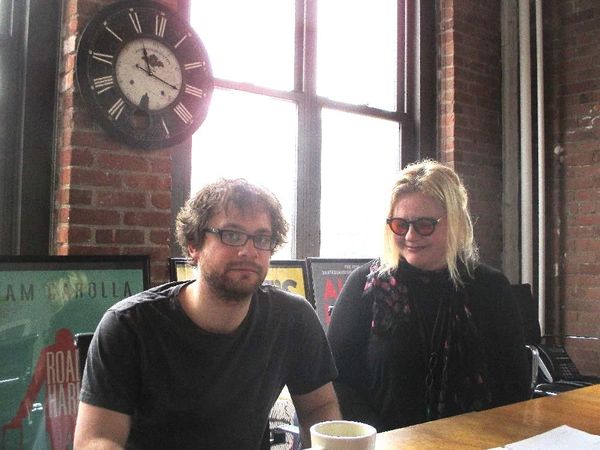 |
| Goodnight Mommy directors Severin Fiala and Veronika Franz on Ulrich Seidl and Michael Haneke: "It seems to be true because many artists reflect that kind of atmosphere." Photo: Anne-Katrin Titze |
Veronika Franz and Severin Fiala's Goodnight Mommy starring Lukas Schwarz, Elias Schwarz and Susanne Wuest, produced by Ulrich Seidl is the corner of your mind where Stanley Kubrick, Alfred Hitchcock, Georges Franju, Damien Hirst and Michael Haneke meet in Nobuhiko Obayashi's House (Hausu) and invite Gregor Samsa to converge with the von Trapp family.
After a short prelude in the form of a clip from an Austrian version of the Sound Of Music story, starring Ruth Leuwerik, we settle into the country house of a woman (Wuest) who has just undergone extensive facial surgery. Her twin sons, Lukas and Elias, are seen spending the time on the grounds around the isolated house.
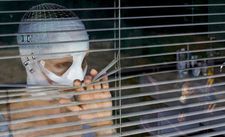 |
| Hello Mommy Susanne Wuest: "That gap between reality and the image of the perfect family was what interested us." |
Fiala and Franz use two of the most beloved German goodnight songs and build a sleek, not un-American horror movie on these pillars to dreamland, with cinematography by Martin Gschlacht.
Anne-Katrin Titze (half-jokingly): Seeing your film, I thought this is the who's who of everything that ever scared me: twins from The Shining, face surgery from Georges Franju's Eyes Without A Face, "I see dead people," the cat from the Japanese horror film Hausu - the cat doubled here in Damien Hirst suspension, the bugs are little Gregor Samsas, and then, of course the von Trapp family…
Veronika Franz: They scared you too?
AKT: Oh very much! And lastly, the cornfields and the pesticide sprayed on Cary Grant in Hitchcock's North By Northwest. Were you constructing your movie by picking frightening moments? How did the plot come about?
Lukas and Elias play Hide and Seek in a cornfield and rescue a cat from a pile of skulls in the vault of an overgrown cemetery.
Severin Fiala: Much easier. Actually, we were just watching television. On German TV there are docu-soaps about women who have plastic surgery performed on them. They get a complete make-over: hair done, teeth done, new clothes, new nose, maybe. They are separated for that purpose from their families for some months and then they are reunited in this red carpet television moment when the new mothers, the more beautiful mothers, come back to their families. Because it's TV, it has to be a happy moment but when you look closely to the eyes of the children, the first glance they get of her is always a bit irritated and scared. We even saw an episode where a little girl said, "this is not my mother." Moments like that inspired us for the screenplay.
 |
| Twin masks Elias and Lukas: "They are pre-pubescent and the other part is that they kind of want to see her without any bandages." |
Veronika: The basic situation.
Severin: And then it was a mind game. How could this evolve? That was the way we constructed the story. We love horror films and we've seen tons of them. We didn't consciously pick this from this film or that film. Maybe it's just in our bodies and minds.
Veronika: We've been watching them for twenty years together. Of course, cornfields - you have in horror film, as in every genre film, you have certain topoi. We are aware of that, we use that in a way, the cornfield is common….
Severin: But I played in cornfields when I was a little boy!
Veronika: Yes, mixed with personal memories and ideas.
Severin: It seems that my personal memories are like common horror film clichés!
AKT: Where did you grow up?
Severin: In the countryside in Austria between cornfields. And a friend of mine had cockroaches as pets.
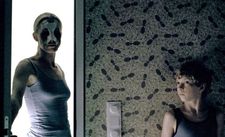 |
| Goodnight Mommy bugs: "That balance was hard - to have her look strange and scary but it should work for her character, too." |
AKT: I couldn't help thinking of Kafka with the bugs and what might have been transformed. I do want to ask you about the clip you picked for the start. I had to really search my brain to remember the actress's name, Ruth Leuwerick. American audiences might see that clip and think, "Sound Of Music, but not Sound Of Music." Was that the idea behind the clip - like Mommy, but not Mommy?
Severin: No, not in this specific way. Maybe the same idea as what you just said but not in the Sound Of Music and other von Trapp film [context]. But more that you see the image of a perfect family who stands together and sings together but it's too perfect and creepy because you know, it can't be real. That gap between reality and the image of the perfect family was what interested us.
Veronika: The song is also the bracket of the film at the beginning and the end. We had the theme of [the lullaby] "Guten Abend, Gute Nacht" and it all came together. I think at the beginning of the film it sets the right tone between the idyll and the frightening that's behind that, under the surface, behind the cliché.
Severin: It's an Austrian family movie.
Veronika: They [the von Trapps] are the most famous Austrian family.
AKT: To stay with the song for a moment. Did you change the lyrics? "Kennt auch dich und hat dich lieb," [knows you too, and loves you very much] is a line I've never heard in the lullaby.
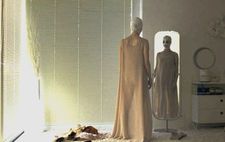 |
| Mommy in the mirror: "We as filmmakers can't explain too much about her because the mystery would disappear in a way." |
Both at first protest that they did not change the lyrics.
Severin: Actually, we didn't change it but the actress [Susanne Wuest] did. We told her to sing the song and she sang it that way. And we had never heard it that way with that last line but we thought it was good, so we kept it.
Veronika: Yes, she edited it. She knew it that way and sang it that way and we said okay.
AKT: It again fits with the theme of the movie, the familiar song ends on a totally unfamiliar note. You came up with a brilliant way to give the audience background on the mother by having them play a guessing game with post-its on their forehead.
Veronika: I played that game with my children many times. You played it, too. Who's who?
Severin: Because it's told from the children's perspective, it's quite hard to give information about the mother's character. We as filmmakers can't explain too much about her because the mystery would disappear in a way. We tried to find ways to convey information about the mother. One is the game, another one is the house.
Veronika: How it's decorated, what paintings are hanging on the walls.
AKT: The mother is dressed in the colors of vanilla and strawberry pudding and she wears platform heels to do things around the house. What were your thoughts on putting her in these costumes [by Tanja Hausner]?
Veronika: We're always character driven. What would a television presenter wear? In the beginning she comes from the hospital, so it must be something more casual. And the colours, we just thought…
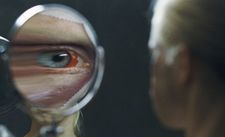 |
| Here's looking at you: "We tried to find ways to convey information about the mother." |
Severin: … of flesh, in a way.
Veronika: That she is almost nude even though she wears clothes. One costume was very difficult to decide. When she shows herself to the boys for the first time without any bandages. How would the hair and makeup be? She would be proud of it but she would look like a robot and very strange to the children. That balance was hard - to have her look strange and scary but it should work for her character, too. To root the situation of the characters also in reality, that was very important to us, even in costumes.
Severin: And the shoes - we simply loved the sound of the shoes. The house is really, really, really big and you hear all the sounds.
AKT: The scene with the mother without clothes in the forest is her Walpurgisnacht?
Veronika: It's a nightmare, of course, of the children. They are pre-pubescent and the other part is that they kind of want to see her without any bandages. The moment where they could see her…
Severin: …the camera spins around and she looks to the other side and you still don't see. And when she is in full frame, the head starts spinning like crazy and they still can't see her! That's kind of the children's nightmare.
AKT: Some things are really funny. The Red Cross people, for example. Are they real?
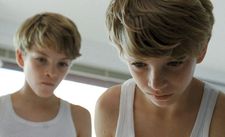 |
| Lukas and Elias Schwarz: "If they showed some talent and it fit, we put it into the film." |
Severin: They're real. Actually, I'm with the Red Cross and those are my colleagues.
AKT: They are lovely. And they need the money!
Severin: I've done worse, actually.
AKT: You've left people in danger?
Severin: You have to collect some funds first.
AKT: I have never heard such impressive burping in my life. The boys' burping competition is without equal. They just did that and you took it and put in your movie?
Severin: Definitely.
Veronika: We wanted to be open during the shooting, like the hail that was not in the script, originally. Same with the boys. If they showed some talent and it fit, we put it into the film.
Severin: It was so hard in the editing room because we never knew where to put that scene.
AKT: it can stand on its own, you could make a trailer for the film just with that.
Veronika: It goes on for much longer. They did it like ten minutes. We could use that for the DVD.
AKT: Would you say there is something specifically Austrian about your movie?
Veronika: People tell us there is. I think what unifies these Austrian films is that it's a lot about not communicating with each other. It's this silent, cold, living together. We communicate differently than Germans do, for example. I think Austrians are not so straightforward as Germans are. It's kind of not speaking out.
AKT: And going once around the mountain instead?
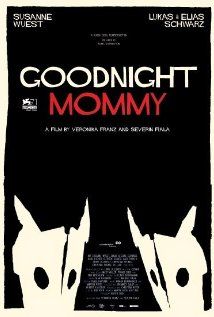 |
| Goodnight Mommy poster |
Veronika: Yes, exactly. Very often it's covering true emotions or true feelings. That unifies. Ulrich Seidl also tells about not communicating, Michael Haneke does that, too. Maybe that's very Austrian. It seems to be true because many artists reflect that kind of atmosphere.
AKT: I spoke with Lukas Valenta Rinner about his film in New Directors/New Films, Parabellum. I asked him the same question, and he laughed and said he sees himself as a Latin American filmmaker.
Veronika: Actually, visually, I think his film is very Austrian. I saw the trailer and thought, okay, looks like an Austrian film.
AKT: We haven't spoken about the church, yet. In your film there are crosses on the wall and the sexton is an interesting character.
Veronika: Obviously there is a spiritual dimension of the film and we thought that one of the twins would be religious.
Severin: The sexton [Christian "the pelikan" Steindl] is really great. Our casting people found him. You can talk to him normally, but he would answer with a ten second delay. The scene with the children was the first time they met. They didn't know who was in the church. We told them to run in and ask someone for help. After the scene they said they really wanted to stop because they didn't know what happened.
AKT: This is your first time directing - did you start out wanting to make a horror movie?
Severin: We didn't start with the label.
Veronika: But we are very much in love with the genre.
Severin: We wanted to make a film that we both would like to see. Our two next projects aren't horror films but there are always elements of that genre because we love it.
AKT: What are these two new projects about?
Severin: Both have executioners in it. One in the 18th century and one in the 1950s. That one is about the last executioner of Vienna who was at the time only a part-time executioner after the Second World War. In his other job, he was a film projectionist. The cinema was very close to the place where he executed people. Austria had a very specific way of executing people. It's not that they are hanged as you know from American cinema but they are more or less strangled from behind, against a pole.
Veronika: It's called "Würgegalgen." [Suffocating Gallows].
Severin: They used it from 1870 to 1950 and never changed it.
AKT: And the other cheery project from the 18th century?
Severin: It's about depressive women at that time who couldn't kill themselves because religion forbid it. It's the worst crime because you can't confess afterwards. So they got another idea how to die - to kill other people and be executed for that. Because before the execution you can confess to a priest and then go to heaven. They mostly killed innocent children and got executed for that. There are over three hundred cases all over Europe in the 18th century.
Veronika: We have the original court protocols. An American scholar is the only one who documented all these cases and is researching this phenomenon. She calls it "Suicide by Proxy." It took place in Austria, Germany, Sweden, France and England and nobody knows about that. Her name is Kathy Stuart, she does research and is writing a book about it. She opened all her cases up for us so we could read all these court protocols. It's in a way very touching because they were simple women, wives of farmers, and how they describe the misery of their lives.
Goodnight Mommy will change your attitude towards super-glue, pepperoni pizza and Red Cross volunteers soliciting charity donations.





















